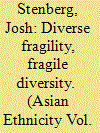| Srl | Item |
| 1 |
ID:
191778


|
|
|
|
|
| Summary/Abstract |
Attending to postwar Chinese-language letters in Indonesia and the Philippines reveals a stronger tendency to write within a discourse of long-distance cultural nationalism than in hybrid or local modes. Omitting cultural nationalist discourses from a view of the corpus risks skewing accounts of Sinophone production, since many authors who write in Chinese have been receptive to ethnic, cultural, and even political appeals from China. This result is also ironic, in that it is specifically production in Chinese (rather than in imperial or archipelagic languages) which is most in tension with the postmodern and postcolonial bent of the Sinophone turn. As an open system for interrogating essentialist definitions of ‘Chineseness’, Sinophone Studies should also accommodate the culturally (and sometimes politically) orthodox ‘Chinese’ strands of Southeast Asian writing. Considering non- or less-hybrid strands of the corpus in turn opens new avenues for understanding the region’s Sinophone cultural production as the result of a rich, politically diverse network with considerable scope for comparative intraregional study.
|
|
|
|
|
|
|
|
|
|
|
|
|
|
|
|
| 2 |
ID:
191775


|
|
|
|
|
| Summary/Abstract |
This paper examines the historical antecedents of the terminologies ascribed to the Chinese in the Philippines, focusing on the late Spanish to the early American colonial periods. Many government records, newspapers, or books categorized the “Chinese” as either sangley, intsik, Chinese mestizo, or “Chinese/Chino,” in contradistinction to Christianized natives who were labeled as “Indios” and later “Filipinos.” Following dominant and nationalized classifications of race, past scholarship on the Chinese in the Philippines also tended to paint the “Chinese” in the Philippines in a binarist opposition against “Filipinos.” The essentialization of ethnicities has resulted in the perpetuation of a homogenized and monolithic “Chinese” identity that we see in the country today. Using government and non-government publications from the period under study, this paper seeks to demonstrate the power dynamic at particular moments in Philippine society that has led to the reification, reinvention, and reconfiguration of what it means to be “Chinese.”
|
|
|
|
|
|
|
|
|
|
|
|
|
|
|
|